Menu
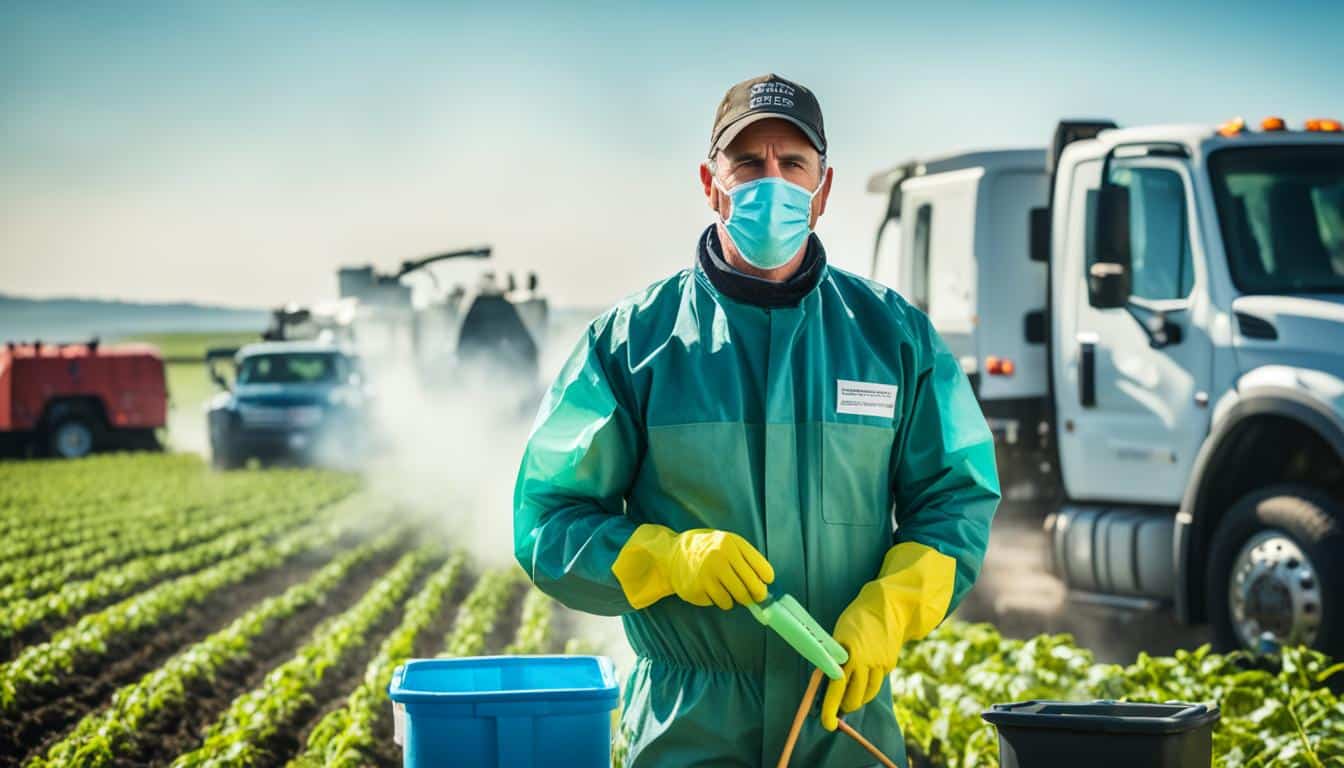
Between 1901 and 2000, the United States made big strides in veterinary public health and preventive medicine. These achievements show how important biosecurity is for keeping farm animals safe during emergencies.
Biosecurity on farms means controlling certain practices to stop diseases from spreading. It involves ways to check, stop, and treat illnesses. This includes things like checking animals, isolating ones that might be sick, vaccinating animals, and keeping a close eye on their health. Taking care of the whole farm helps farmers protect their animals when trouble strikes.
Farm biosecurity stands at the front line in stopping animal diseases. It plays a key role in farm management, especially in tough times. Its significance for the economy, especially in places like California, is very high.
Biosecurity measures stop big losses and trade bans during disease outbreaks. They protect livestock from foreign diseases that can spread widely. By doing this, they help keep the farming sector strong and lasting.
Following biosecurity rules also protects nearby farms, workers, and us as consumers. It helps keep our food supply safe. These steps are crucial during disease outbreaks to ensure the health of animals like livestock and birds.
To manage farms well, especially in crises, understanding and applying biosecurity is key. This protects animal health and stops the spread of diseases. Most importantly, it helps keep our agricultural industry safe and growing.
Setting up good biosecurity for farm animals is vital for their health before and during emergencies. A solid biosecurity plan has many parts, each important for keeping animals safe and farms ready for emergencies.
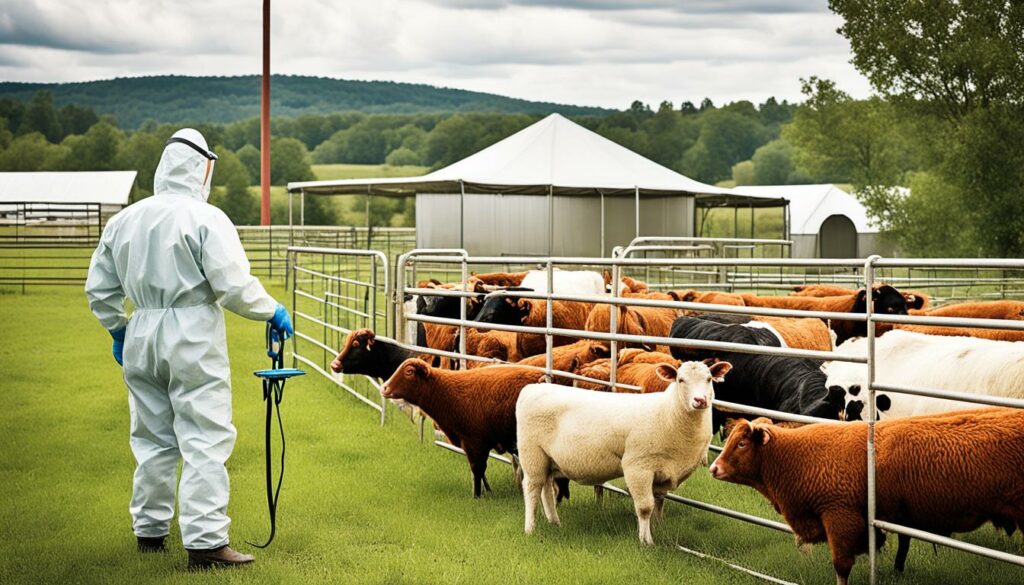
Testing often and carefully is key to keeping farm animals safe. It helps to stop the spread of diseases at their early stages. When diseases are found early, quick action can prevent big problems.
The main aim of testing is to find sick animals fast. This stops diseases from spreading to healthy ones, lowering the risk for all.
Keeping sick or new animals separate is very important. It stops diseases from spreading. It is crucial to follow strict quarantine rules to keep everyone safe during outbreaks.
Control the farm traffic – people, tools, and animals – to keep diseases out. This reduces the risk of new diseases or spreading old ones.
Vaccinating animals is key for health and safety, especially during emergencies. It helps build general immunity, preventing serious outbreaks. Every farm should have a strong vaccination plan to protect their animals.
Sticking to a regular vaccination schedule is vital. It keeps the animals healthy and ready to fight off diseases.
Assessing risks is key in crisis farm settings. It means checking on our biosecurity methods often to spot weak points. Knowing how diseases spread, shown by a study on 24 diseases in pig herds in Europe, highlights why this is so important (Filippitzi, et al., 2018).
Studying how pigs move on farms, like in Iowa and through US census data, shows we must have strong biosecurity. It also helps to look at how worker movements impact the number of pigs born on farms (Black, et al., 2021). This shows us where farms might be at risk.
Sorting risks by how likely animals are to catch diseases and how these diseases get in helps. This way, farmers can make plans that really work. Swiss experts mention this is vital for cattle and pig farms (Kuster, et al., 2015).
By using these ideas, farm management in crisis situations gets stronger. We learn a lot from checking how things are done on Belgian pig farms (Ribbens, et al., 2008).
| Study | Focus | Findings |
|---|---|---|
| Filippitzi, et al., 2018 | Infectious Disease Transmission | 24 diseases preventable by biosecurity measures |
| Passafaro, et al., 2020 | Swine Movement Networks | Highlighting critical biosecurity points in multi-site pig production |
| Moon, et al., 2019 | US Swine Movement Network | Estimating farm-level swine movement patterns |
| Black, et al., 2021 | Worker Movements & Productivity | Correlation between worker activity and pig weaning rates |
| Kuster, et al., 2015 | Biosecurity Practices | Effectiveness in cattle and swine farm biosecurity |
Good farm management in crisis situations means being ready all the time. By keeping an eye on risks and tackling them as they come, we help keep our livestock safe. This is key for the future of farming.
In crises, emergency biosecurity protocols for farmers are vital. These protocols should be easy to act on and reduce the effects of sudden outbreaks. Good preparation means making detailed plans for farm handling, especially where diseases are common.

Farmers must create clear emergency plans, focusing on keeping the farm safe. This involves:
Having solid biosecurity plans can keep cervid herds and other farm animals safe during outbreaks. It improves the chances that healthy animals won’t get sick.
A solid disease outbreak response on farms explains what farmers need to do when they find a disease. This includes efforts to contain the problem and clear ways to talk about it:
These plans are key in fighting off diseases like foot-and-mouth (FMD) and bird flu. The 2022 outbreak in areas like Pennsylvania and Maryland showed how badly it can affect farming and the economy.
Ultimately, strong emergency biosecurity protocols for farmers stop diseases from getting in and spreading. This keeps the food supply safe and the farming economy running well.
Setting up isolation for new animals is key for keeping livestock safe. It stops disease from sneaking in with new or unwell animals. We make sure that these newcomers are away from the herd for 21-30 days to check if they’re healthy.
Quarantine isn’t just about keeping animals apart. It involves watching them closely and making sure they’re not getting sick. Early detection of diseases like Avian Influenza is vital. This approach is very important in the poultry industry to avoid big losses.
It’s crucial to have special areas for isolation and sick animals. This stops diseases that animals can pass to us, from spreading. Good biosecurity keeps the farm running smoothly and avoids diseases that are expensive to deal with.
Using modern ways like Hydroxyl-Based AOP to treat water for livestock helps too. This technology can boost how much protein the animals make, saves on feed, and lessens deaths. It all helps keep the animals healthy.
Keeping farm animals safe in emergencies is crucial, highlighting the importance of strong biosecurity checks. Health checks and good record keeping are key. They help keep biosecurity measures effective. This protects animals and prepares farms for emergencies.
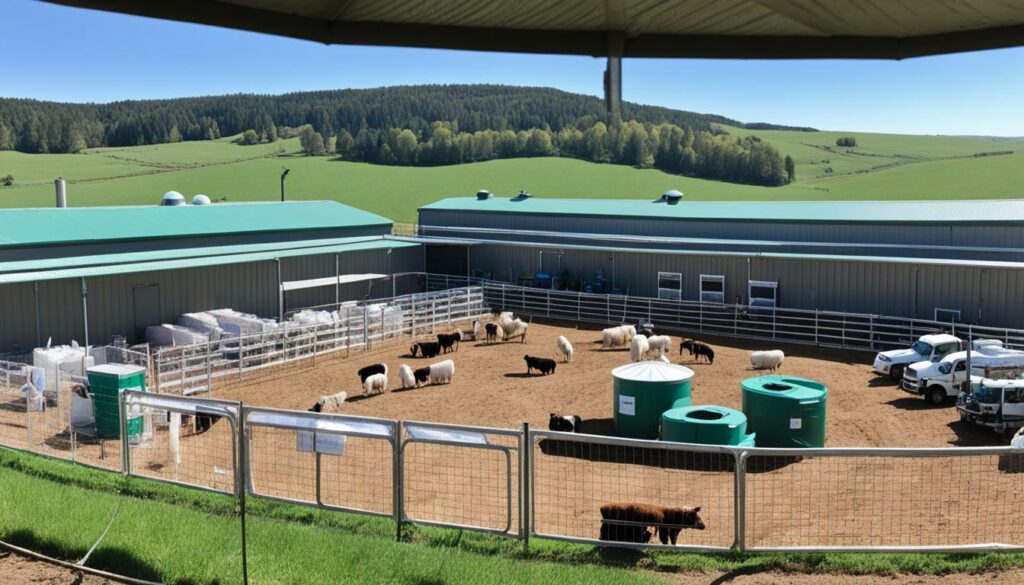
Regular health checks are at the heart of this effort. They allow for quick spotting and fixing of biosecurity issues. By looking at disease spread in pig herds (Filippitzi ME et al., 2018), we see how important it is to watch over our animals carefully.
Health checks early spot health problems. They help protect animals in emergencies. Research by Black NJ et al. (2021) and Passafaro TL et al. (2020) shows how checking health regularly boosts animal health and farm success.
Keeping detailed animal records is crucial. They track health, where animals go, and treatments. These logs help during emergencies, like with disease outbreaks. Studies by Alarcon P et al. (2014) and Casal J et al. (2007) show this. Good records also help make smart farm decisions for the long term.
| Study | Focus Area | Findings |
|---|---|---|
| Filippitzi ME et al., 2018 | Transmission routes of infectious diseases in pig herds | Identified 24 preventable diseases, highlighting the importance of biosecurity measures |
| Schulz LL, Tonsor GT, 2015 | Economic impacts of porcine epidemic diarrhea virus | Significant economic losses underscore the necessity of effective biosecurity |
| Black NJ et al., 2021 | Worker movements and productivity in US swine farms | Consistent health checks improve weaning rates per sow |
| Casal J et al., 2007 | Biosecurity measures in Spain | Comprehensive records enhance emergency response effectiveness |
Regular checks and keeping good records make farms safer. These steps are critical in protecting animals and improving the farm’s overall strength. By making these tasks part of the daily work, farms better face emergencies. This ensures the health and productivity of farming in the long run.
Cleaning and disinfection protocols are key for keeping animals healthy. They are systematic steps to remove germs from surfaces. By following them regularly, we can keep the environment clean and stop diseases from spreading.
Biosecurity means doing everything we can to stop germs getting into places where animals are kept. It is vital for keeping livestock safe. It helps reduce the chance of diseases spreading when people, equipment, or materials move between farms. Biosecurity measures for livestock are also very important during health emergencies, like when we need to watch for new diseases, vaccinate, or dispose of sick animals.
Germs can spread in several ways. If a sick animal breathes out droplets that another animal breathes in, the disease can spread. Eating or touching things contaminated with germs can also make animals sick. Bugs and spiders might also carry these germs from one place to another.
It’s crucial to clean places that are more likely to have germs, like where livestock is unloaded. These places need to be cleaned out before vehicles leave. Then, the vehicles need to be washed with water to get rid of dirt. They might even need to be washed a few times to be really clean.
The disinfectant we use should kill almost all germs (99.9%). We should clean things before using the disinfectant. The instructions for how to do this well can be found in a handbook. Following these steps means we are ready to deal with any health problem quickly.
By following all these steps, we do our best to keep animals healthy. This protects the farms and helps them run smoothly.
Dealing with diseased animals is key to farm biosecurity in emergencies. It’s crucial to have good strategies. These help keep both animals and people safe. They also stop diseases from spreading.
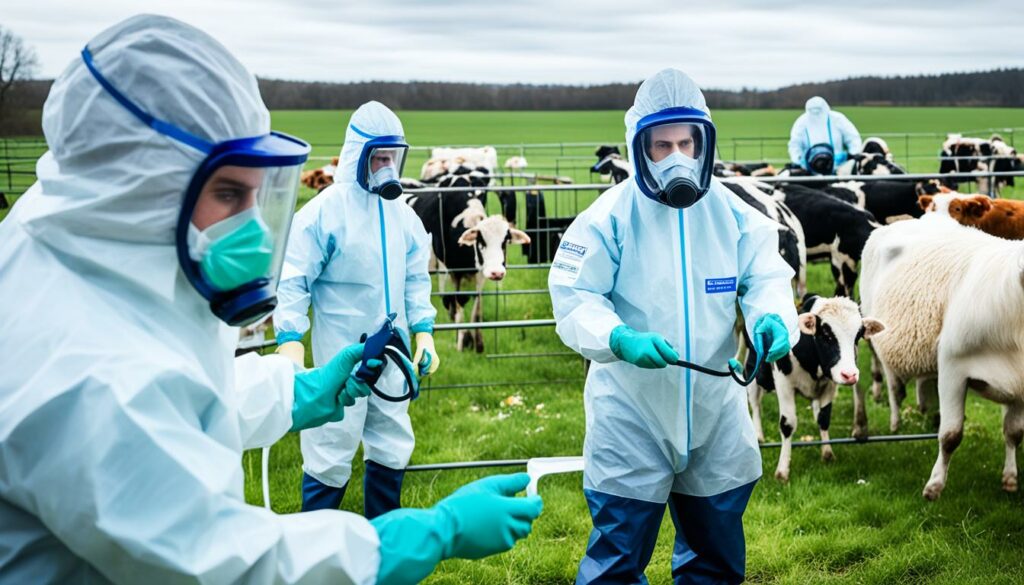
Isolation procedures are very important for sick animals. They involve separating sick animals from the rest. This reduces the chances of disease spreading. By following strict care rules and limiting human contact, diseases can be kept in check.
For example, farms can have protocols. These make sure any new animals are kept away and checked for 14 days. This is before they join the main group. This waiting period helps prevent new diseases from starting.
Quickly telling authorities about diseases is essential. It helps start emergency actions fast. This can limit the disease’s spread and help with support efforts.
If a farmer sees something odd in their animals, they must tell a vet straight away. They should also call the Emergency Animal Disease Hotline at 1800 675 888. Watching for and reporting diseases is critical. It stops diseases such as Foot-and-Mouth from harming livestock.
| Contact | Procedure |
|---|---|
| Veterinarian | Report unusual symptoms immediately. |
| Emergency Animal Disease Hotline | Call 1800 675 888 for immediate disease reporting. |
| NLIS Database | Notify within 48 hours for livestock movements. |
Being prepared and following these steps can save a farm from big losses. This is particularly true for health plans for cervid and domestic animals.
For farmers, properly handling dead animals and manure is very important. It helps prevent diseases from spreading, stops environment pollution, and keeps pests away. By doing these actions carefully, the farm’s health can be protected.
In a crisis, using the right ways to get rid of dead animals is key. In Nebraska, there are five main methods: composting, burial, burning, turning into protein, and dropping in a hole.
During hard times, like in disasters, making big piles to let dead animals decay is a good choice. This can be done using old plant matter. For every 1,000-pound animal, around four large plant piles are needed. The piles should be left alone for three months at least, or longer, then any bones should be buried or put in the trash.
Putting them under the ground is also a good option. But, to not pollute water, place them far from lakes and homes. Enough distance must be kept from water sources others use, like wells, and from big plants that clean the water.
Turning dead animals into protein for other animals is another good way. But it’s not simple; it takes a lot of money and may be hard if the protein needs to be moved far. Plus, certain parts must be taken out to be safe to use.
Setting them on fire can also work, but it’s expensive and not easy for many people to do. This could work better for those with a lot of birds or small animals. Keeping the fire hot enough and clean is important.
When things are hard on the farm, it’s crucial to not attract more problems like wild animals or bugs. By safely getting rid of dead animals and keeping food and water clean, diseases can be stopped.
A rule from 2019 lets Nebraska farmers have more time to bury their dead animals when it’s very cold or hot outside. This helps farmers respond better in difficult times.
Following special rules for getting rid of dead animals and waste protects farms and the area around them. This makes sure animals and people are safer when facing a crisis.
Keeping farm animals safe in emergencies means we must feed and water them well. This helps stop germs from spreading and keeps the animals healthy. In a 2007 study, around 68 percent of U.S. dairy herds had a germ called Johne’s Disease in their environment. This shows the risk of diseases spreading if we don’t take care.
Proper feed storage is key to stop germs from spreading. Feed must be kept in a clean, dry place to stop bacteria and fungi growing. It’s also important to keep the feeding areas clean. This stops pests like flies and rodents from bringing in more germs.
Cleaning water containers is just as important. We should often clean the water to take out germs. Using technology like Hydroxyl-Based AOP in water is very good. It helps animals drink more, digest food better, and stomps out germs and viruses. This means animals can get more nutrition and grow well.
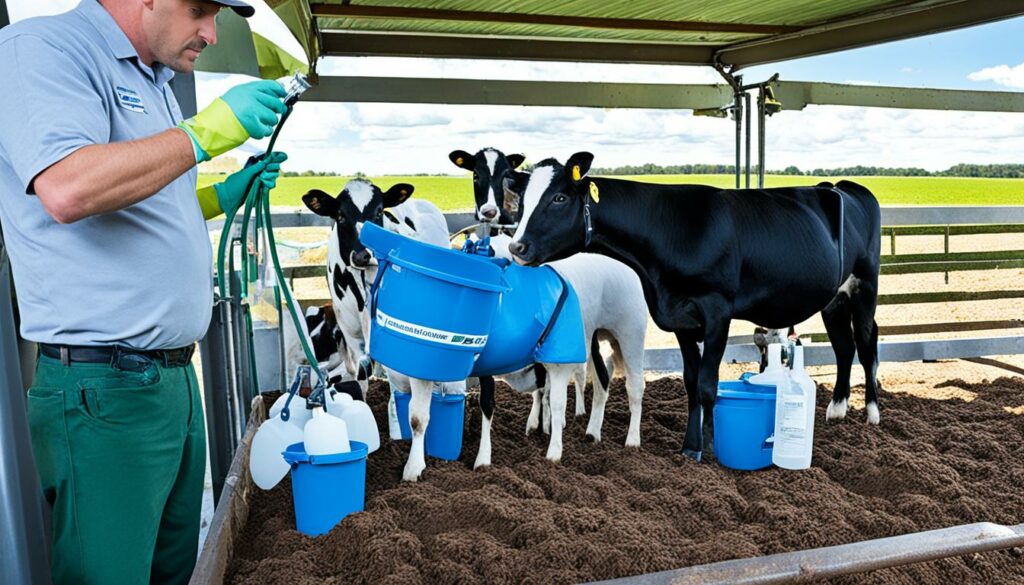
Let’s look at neonate diarrhea in baby calves, caused by E. coli and rotavirus. Good feeding and watering practices can cut down on these diseases. If we do this, it helps not just the animals but also the farmers who might lose a lot of money.
During an emergency, taking extra care with feeding and watering matters a lot. Keeping water and feed clean helps a great deal. This is about protecting the animals from getting sick at a big scale. Plus, it shows we care about keeping the whole farm safe.
Teaching farm staff about biosecurity is vital for keeping farms safe, especially in emergencies. It’s important they understand how to protect the animals and prevent diseases from spreading.
It’s key that everyone follows the right steps when entering farms to keep the animals healthy. This involves cleaning footwear in special footbaths, making sure vehicles and tools are clean, and controlling who can enter. Doing these things significantly cuts the risk of diseases spreading. This part is crucial during emergencies as it’s the first defence against diseases.
Wearing the correct gear is essential in protecting the animals. Staff should wear overalls, gloves, and boots that are either cleaned well or thrown away after use. This stops harmful germs from spreading. It’s important that all staff know how to use this protective equipment right, especially in emergencies.
When there’s an animal health crisis, using the right protective clothing is critical. It helps stop diseases from getting into the farm and spreading. This is important because diseases can make animals very sick, cause death, and lead to big financial losses. With proper training, we can help keep our farms safe from these dangers.
“Biosecurity awareness stresses the importance of training emergency response personnel to adhere strictly to incident-specific biosecurity plans to prevent pathogen transmission.”
Biosecurity steps are there to stop diseases, protecting both animals and farming as a whole. The USDA’s training helps vets and vet techs get essential credits. This ensures they deeply understand how to keep farms safe, from practices to emergency plans.
Farm biosecurity in emergencies is vital. It’s the foundation of preventing diseases in animals for farmers. An in-depth knowledge of sicknesses like Johne’s Disease is crucial. This is shown by 68% of U.S. dairy herds finding a positive test in their environment.
The huge cost of neonatal calf diarrhoea and diseases like E. coli underline biosecurity’s critical role. It shows why comprehensive steps must be taken.
Vaccines are key in any farm’s protection plan. They start the defence against sicknesses. Working with vets helps create a strong biosecurity plan. This looks after animal health, isolates new animals, and keeps visitors safe. This reduces the chance of spreading diseases.
Looking at pig herds in Europe, their biosecurity steps stopped 24 diseases. This proves the power of these precautions.
Analysing how pigs move around and economic studies show strict biosecurity and careful use of medicines improve animal health. Tools like Biocheck.UGent help check and better biosecurity. This leads to stronger and lasting farming practices. A full approach to biosecurity in tough times protects animals, secures farms, and strengthens the farming sector against disease.
Important steps in livestock biosecurity include careful examination, isolation, and vaccination. These are crucial. They help spot and stop diseases from spreading. This protects the health and well-being of farm animals, especially when emergencies happen.
Screening and testing help farms stay safe from diseases. Early Pathogen Pathogen detection is their main goal. This is important for fast and efficient disease control. They are key in keeping livestock healthy.
Keeping new or sick animals away from healthy ones is vital. It stops diseases from spreading. A set period of isolation time allows for disease signs to show. This helps keep the whole herd healthy.
Vaccines are critical for making herds stronger against diseases. They lower the chance of big disease outbreaks. This is a major part in keeping livestock healthy during tough times.
Risk checks help farmers find weak spots in their safety plans. They analyse how diseases could enter. This helps set up targeted ways to keep their animals safe during emergencies.
Being ready means having clear plans to act quickly in a disease outbreak. This includes isolating animals, updating on vaccines, and controlling animal movement. Such steps are vital in stopping disease spread fast.
During an outbreak, they must act fast. This means setting up limits, contacting local authorities, and getting immediate medical help. Quick, organised actions are key in ending the outbreak.
It stops new animals from passing diseases to the herd. A short quarantine lets farmers check for diseases first. This way, they avoid major disease issues.
Checking on animals often means catching health problems early. This is vital for keeping their surroundings and the livestock safe. It helps make sure their safety plans work well.
Good records offer a full view of animal health and care. They help in quick and effective action during outbreaks. They also guide new safety practices, boosting overall safety.
Following strict cleaning and disinfection rules is crucial. It helps keep the farm germ-free. This stops diseases from spreading.
Effective isolation means having clear spaces and strict rules for the sick. This stops diseases from spreading. It’s a must-do during emergencies.
Telling the vet right away triggers emergency steps. It helps track down diseases and informs the public about risks. Swift reporting is vital in outbreaks.
Following disposal rules cuts disease spread. It also stops pests and keeps the farm safe. These steps are crucial in farm safety.
Proper carcass and waste disposal, plus safe food storage, keeps pests away. This lessens the risk of disease coming from wild animals.
Keeping feed areas clean and food well-stored is key. This keeps animals safe from sickness. It’s important for their well-being.
Training involves entry cleanliness and how to use protective wear. Educating staff on these keeps the farm and animals safe from diseases spreading.
Wearing the right protective gear stops the spread of illness. This stops germs from moving around the farm. It keeps animals health safe.